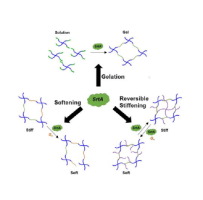当前位置:
X-MOL 学术
›
Acta Biomater.
›
论文详情
Our official English website, www.x-mol.net, welcomes your feedback! (Note: you will need to create a separate account there.)
Dynamic control of hydrogel crosslinking via sortase-mediated reversible transpeptidation.
Acta Biomaterialia ( IF 9.7 ) Pub Date : 2018-11-08 , DOI: 10.1016/j.actbio.2018.11.011 Matthew R Arkenberg 1 , Dustin M Moore 1 , Chien-Chi Lin 1
Acta Biomaterialia ( IF 9.7 ) Pub Date : 2018-11-08 , DOI: 10.1016/j.actbio.2018.11.011 Matthew R Arkenberg 1 , Dustin M Moore 1 , Chien-Chi Lin 1
Affiliation

|
Cell-laden hydrogels whose crosslinking density can be dynamically and reversibly tuned are highly sought-after for studying pathophysiological cellular fate processes, including embryogenesis, fibrosis, and tumorigenesis. Special efforts have focused on controlling network crosslinking in poly(ethylene glycol) (PEG) based hydrogels to evaluate the impact of matrix mechanics on cell proliferation, morphogenesis, and differentiation. In this study, we sought to design dynamic PEG-peptide hydrogels that permit cyclic/reversible stiffening and softening. This was achieved by utilizing reversible enzymatic reactions that afford specificity, biorthogonality, and predictable reaction kinetics. To that end, we prepared PEG-peptide conjugates to enable sortase A (SrtA) induced tunable hydrogel crosslinking independent of macromer contents. Uniquely, these hydrogels can be completely degraded by the same enzymatic reactions and the degradation rate can be tuned from hours to days. We further synthesized SrtA-sensitive peptide linker (i.e., KCLPRTGCK) for crosslinking with 8-arm PEG-norbornene (PEG8NB) via thiol-norbornene photocrosslinking. These hydrogels afford diverse softening paradigms through control of network structures during crosslinking or by adjusting enzymatic parameters during on-demand softening. Importantly, user-controlled hydrogel softening promoted spreading of human mesenchymal stem cells (hMSCs) in 3D. Finally, we designed a bis-cysteine-bearing linear peptide flanked with SrtA substrates at the peptide's N- and C-termini (i.e., NH2-GGGCKGGGKCLPRTG-CONH2) to enable cyclic/reversible hydrogel stiffening/softening. We show that matrix stiffening and softening play a crucial role in growth and chemoresistance in pancreatic cancer cells. These results represent the first dynamic hydrogel platform that affords cyclic gel stiffening/softening based on reversible enzymatic reactions. More importantly, the chemical motifs that affords such reversible crosslinking were built-in on the linear peptide crosslinker without any post-synthesis modification. STATEMENT OF SIGNIFICANCE: Cell-laden 'dynamic' hydrogels are typically designed to enable externally stimulated stiffening or softening of the hydrogel network. However, no enzymatic reaction has been used to reversibly control matrix crosslinking. The application of SrtA-mediated transpeptidation in crosslinking and post-gelation modification of biomimetic hydrogels is innovative because of the specificity of the reaction and reversible tunability of crosslinking kinetics. While SrtA has been previously used to crosslink and fully degrade hydrogels, matrix softening and reversible stiffening of cell-laden hydrogels has not been reported. By designing simple peptide substrates, this unique enzymatic reaction can be employed to form a primary network, to gradually soften hydrogels, or to reversibly stiffen hydrogels. As a result, this dynamic hydrogel platform can be used to answer important matrix-related biological questions that are otherwise difficult to address.
中文翻译:

通过分选酶介导的可逆转肽作用动态控制水凝胶交联。
其交联密度可以动态和可逆地调节的载有细胞的水凝胶在研究病理生理细胞命运过程(包括胚胎发生、纤维化和肿瘤发生)方面受到高度追捧。特别努力的重点是控制聚乙二醇(PEG)基水凝胶中的网络交联,以评估基质力学对细胞增殖、形态发生和分化的影响。在这项研究中,我们试图设计允许循环/可逆硬化和软化的动态 PEG 肽水凝胶。这是通过利用可逆酶促反应实现的,该反应提供特异性、双正交性和可预测的反应动力学。为此,我们制备了 PEG-肽缀合物,使分选酶 A (SrtA) 能够诱导可调水凝胶交联,而与大分子单体含量无关。独特的是,这些水凝胶可以通过相同的酶促反应完全降解,并且降解速率可以从几小时调整到几天。我们进一步合成了 SrtA 敏感肽接头(即 KCLPRTGCK),用于通过硫醇-降冰片烯光交联与 8 臂 PEG-降冰片烯(PEG8NB)交联。这些水凝胶通过在交联过程中控制网络结构或在按需软化过程中调整酶参数来提供不同的软化范例。重要的是,用户控制的水凝胶软化促进了人间充质干细胞 (hMSC) 在 3D 中的扩散。最后,我们设计了一种带有双半胱氨酸的线性肽,其N端和C端侧翼有SrtA底物(即NH2-GGGCKGGGKCLPRTG-CONH2),以实现循环/可逆水凝胶硬化/软化。我们发现基质硬化和软化在胰腺癌细胞的生长和化疗耐药性中发挥着至关重要的作用。这些结果代表了第一个动态水凝胶平台,它提供基于可逆酶反应的循环凝胶硬化/软化。更重要的是,提供这种可逆交联的化学基序内置在线性肽交联剂上,无需任何合成后修饰。意义陈述:充满细胞的“动态”水凝胶通常被设计为能够在外部刺激下使水凝胶网络变硬或软化。然而,还没有使用酶反应来可逆地控制基质交联。由于反应的特异性和交联动力学的可逆可调性,SrtA介导的转肽作用在仿生水凝胶的交联和凝胶化后修饰中的应用具有创新性。虽然 SrtA 之前已被用于交联和完全降解水凝胶,但尚未报道载有细胞的水凝胶的基质软化和可逆硬化。通过设计简单的肽底物,这种独特的酶促反应可用于形成初级网络,逐渐软化水凝胶,或可逆地硬化水凝胶。因此,
更新日期:2018-11-09
中文翻译:

通过分选酶介导的可逆转肽作用动态控制水凝胶交联。
其交联密度可以动态和可逆地调节的载有细胞的水凝胶在研究病理生理细胞命运过程(包括胚胎发生、纤维化和肿瘤发生)方面受到高度追捧。特别努力的重点是控制聚乙二醇(PEG)基水凝胶中的网络交联,以评估基质力学对细胞增殖、形态发生和分化的影响。在这项研究中,我们试图设计允许循环/可逆硬化和软化的动态 PEG 肽水凝胶。这是通过利用可逆酶促反应实现的,该反应提供特异性、双正交性和可预测的反应动力学。为此,我们制备了 PEG-肽缀合物,使分选酶 A (SrtA) 能够诱导可调水凝胶交联,而与大分子单体含量无关。独特的是,这些水凝胶可以通过相同的酶促反应完全降解,并且降解速率可以从几小时调整到几天。我们进一步合成了 SrtA 敏感肽接头(即 KCLPRTGCK),用于通过硫醇-降冰片烯光交联与 8 臂 PEG-降冰片烯(PEG8NB)交联。这些水凝胶通过在交联过程中控制网络结构或在按需软化过程中调整酶参数来提供不同的软化范例。重要的是,用户控制的水凝胶软化促进了人间充质干细胞 (hMSC) 在 3D 中的扩散。最后,我们设计了一种带有双半胱氨酸的线性肽,其N端和C端侧翼有SrtA底物(即NH2-GGGCKGGGKCLPRTG-CONH2),以实现循环/可逆水凝胶硬化/软化。我们发现基质硬化和软化在胰腺癌细胞的生长和化疗耐药性中发挥着至关重要的作用。这些结果代表了第一个动态水凝胶平台,它提供基于可逆酶反应的循环凝胶硬化/软化。更重要的是,提供这种可逆交联的化学基序内置在线性肽交联剂上,无需任何合成后修饰。意义陈述:充满细胞的“动态”水凝胶通常被设计为能够在外部刺激下使水凝胶网络变硬或软化。然而,还没有使用酶反应来可逆地控制基质交联。由于反应的特异性和交联动力学的可逆可调性,SrtA介导的转肽作用在仿生水凝胶的交联和凝胶化后修饰中的应用具有创新性。虽然 SrtA 之前已被用于交联和完全降解水凝胶,但尚未报道载有细胞的水凝胶的基质软化和可逆硬化。通过设计简单的肽底物,这种独特的酶促反应可用于形成初级网络,逐渐软化水凝胶,或可逆地硬化水凝胶。因此,


























 京公网安备 11010802027423号
京公网安备 11010802027423号